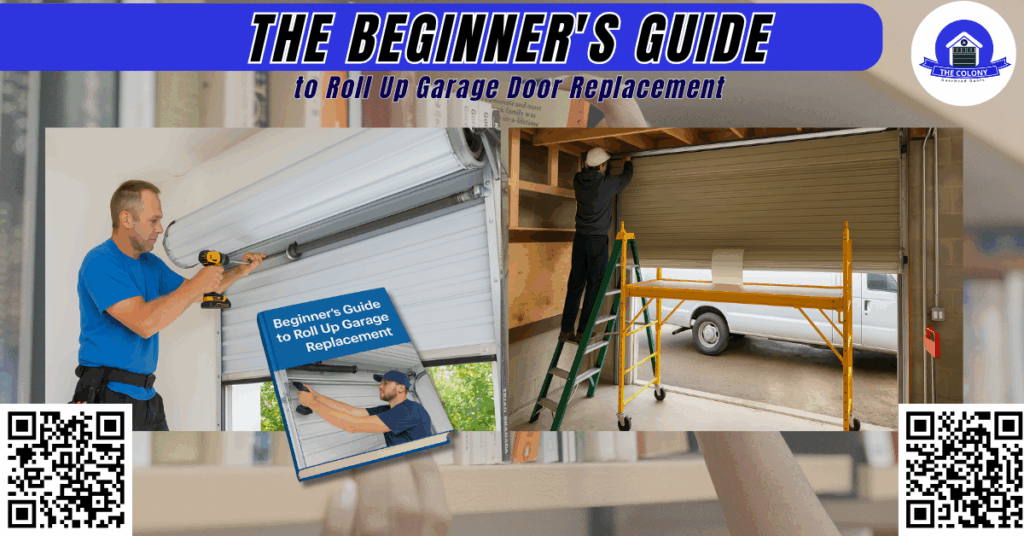It was a scorching summer afternoon in The Colony, TX, when Mr. Allen called us. His roll-up garage door had stopped halfway while closing, exposing his insulated garage and leaving his tools and car vulnerable to the Texas heat. Our crew arrived within hours, discovered rusted steel panels and a faulty garage door opener, and replaced the entire door system with a modern insulated roll-up model. His garage stayed cooler, quieter, and more secure from that day forward.
Here’s a fact many homeowners don’t realize: garage doors are responsible for up to 30% of heat loss in a home. That means an outdated or non-insulated door could be costing you big on your energy bills. In places like The Colony, where both heat and storms can be intense, having an insulated, energy-efficient garage door is not just smart, it’s essential.
Whether you’re dealing with an old, noisy system or you’re planning to upgrade to a more modern style, this beginner’s guide will walk you through everything you need to know about roll-up garage door replacement, including materials, costs, insulation types, and why it’s worth the investment.
What Is a Roll Up Garage Door?
A roll-up garage door is a space-saving door design that opens by rolling into a coil above the door frame, rather than swinging outward or upward like sectional doors. You’ve probably seen them in storage units, commercial warehouses, and even many homes across The Colony and surrounding areas.
They’re made from steel, aluminum, or fiberglass panels (called slats), and are often insulated with polyurethane or polystyrene foam to improve energy efficiency and temperature control inside the garage. Unlike standard garage doors, roll-up models don’t require ceiling tracks or hinges, making them ideal for tight garage spaces or modern insulated garages.
Benefits of Replacing Your Old Roll Up Garage Door
Replacing your garage door is more than a cosmetic upgrade; it’s a smart investment. Here’s why:
✅ Better Energy Efficiency
Old garage doors, especially non-insulated ones, are a major source of energy loss. An insulated garage door with a high R-value helps prevent heat transfer, which keeps your garage cooler in the summer and warmer in the winter.
✅ Reduced Energy Bills
Installing a new door with insulated materials like urethane or styrofoam improves your U-value and cuts down on heat insulation loss, saving money on your monthly energy bills.
✅ Enhanced Comfort and Noise Reduction
High-quality garage door insulation reduces outside noise and maintains a consistent temperature inside your garage, which is ideal if you use it as a workshop, gym, or storage space.
✅ Improved Safety and Technology
Today’s garage door openers come with smart features, logic boards, and backup battery options. You can even connect some models to smart home devices and control them with your phone.
✅ Curb Appeal and Home Value
An insulated, steel roll-up garage door gives your home a sleek, modern look and can offer a strong return on investment. Buyers notice new garage doors, especially craftsman garage doors, Clopay, Martin, or Amarr garage doors.
Step-by-Step Guide to Roll Up Garage Door Replacement
Replacing a roll-up garage door doesn’t have to be overwhelming. Here’s a simple breakdown of how the process works:
1. Evaluate the Current Door
Check for damage, dents, rusted tracks, or poor sealing. If your door has cracks in the insulation, thermal transfer issues, or struggles with lifting, it’s time for an upgrade.
2. Choose the Right Insulation Type
You’ll want to compare polyurethane vs polystyrene foam, or go with batt insulation or rigid foam panels. The higher the R-value, the better the insulation. Urethane provides a dense, high-performing barrier against heat and cold.
3. Pick the Best Materials
Common garage door materials include:
- Steel – Strong, weather-resistant, often insulated.
- Aluminum – Lightweight and rust-resistant.
- Fiberglass – Good for coastal or humid areas, moderate insulation.
Each has pros and cons depending on climate, cost, and your home’s style.
4. Select Door Style and Features
Modern insulated garage doors come in a wide range of styles, including sectional doors, single doors, and custom garage door kits. Look for models that include:
- Weather stripping and seals
- Smart garage door opener with Wi-Fi
- Backup battery and motion lighting
- Compatibility with Chamberlain garage door or Craftsman systems
5. Professional Installation
Roll-up garage doors are heavy and complex. Our team at The Colony Overhead Doors installs each system with precision, handling tension springs, insulation material, and all electrical components safely.
6. Test and Tune-Up
Once installed, we test all parts: opener motor, remotes, wall controls, and safety sensors. We also check that the insulation is working correctly and that the garage space is sealed from outside weather.
Cost of Replacing a Roll-Up Garage Door
The initial cost of replacing a roll-up garage door varies based on:
- Size and style of the door
- Insulation type (polyurethane vs polystyrene)
- Garage door opener features
- Material used (steel, aluminum, fiberglass)
- Local installation and labor rates
On average, homeowners in The Colony, TX can expect to spend between $1,200 and $3,500, including installation. Choosing energy-efficient options can lead to greater energy savings over time.
Choosing Between Insulated vs Non-Insulated Doors
Here’s a quick pros and cons table to help you decide:
| Feature | Insulated Doors | Non-Insulated Doors |
| Energy Efficiency | ✅ Excellent (high R-values, low U-values) | ❌ Poor temperature control |
| Noise Reduction | ✅ Quieter operation | ❌ Louder, especially in wind/rain |
| Cost | ❌ Higher initial investment | ✅ Lower up-front cost |
| Durability | ✅ More resistant to dents and weather | ❌ Prone to warping, cracking |
| Ideal For | Climate control, garages as workspaces | Storage-only or detached garages |
Tips to Maintain Your New Roll Up Door
- Lubricate the tracks and springs every few months.
- Clean debris from the guides and rollers.
- Inspect weather seals and replace if worn.
- Schedule annual checkups with The Colony Overhead Doors.
- Use garage door guides to troubleshoot minor issues.
How Can The Colony Overhead Doors Help You?
If you’re ready to replace your outdated or inefficient roll-up garage door, let our experts guide you every step of the way. At The Colony Overhead Doors, we specialize in installing insulated garage doors that improve your home’s comfort, safety, and energy efficiency.
🏠 Serving homeowners and businesses in The Colony, TX, and surrounding areas
📍 Visit us at: 5321 State Hwy 121, The Colony, TX 75056
📞 Call us today: (469) 716-5785
From selecting the right garage door insulation kit to professional installation, we’re here to help make your home more comfortable, efficient, and secure. Trust the local experts who know garage doors inside and out.
Frequently Asked Questions (FAQs)
1. How long does a roll-up garage door replacement take?
Most roll-up garage door replacements can be completed within 4 to 6 hours, depending on the size of the door and whether any structural repairs are needed.
2. Can roll-up garage doors be painted to match my home’s exterior?
Yes, many roll-up doors come with paintable surfaces or pre-finished colors that can be matched to your home’s exterior using weather-resistant paint.
3. Are roll-up garage doors suitable for high-wind or hurricane-prone areas?
Yes, you can choose wind-rated or impact-resistant roll-up doors specifically designed to withstand extreme weather conditions.
4. Is it possible to automate an existing manual roll-up garage door?
In many cases, a manual roll-up garage door can be retrofitted with an electric opener, though it depends on the door’s structure and condition.

